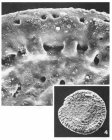Foraminifera taxon details
Cycloloculina Heron-Allen & Earland, 1908 †
722272 (urn:lsid:marinespecies.org:taxname:722272)
accepted
Genus
Cycloloculina annulata Heron-Allen & Earland, 1908 † accepted as Cycloloculina eocaenica (Terquem, 1882) † (type by subsequent designation)
- Species Cycloloculina boninensis Matsumaru, 1996 †
- Species Cycloloculina eocaenica (Terquem, 1882) †
- Species Cycloloculina punctata (Terquem, 1882) †
- Species Cycloloculina annulata Heron-Allen & Earland, 1908 † accepted as Cycloloculina eocaenica (Terquem, 1882) †
- Species Cycloloculina costellata (Terquem, 1882) † accepted as Sherbornina costellata (Terquem, 1882) † (Opinion of Hayward (1978))
- Species Cycloloculina cubensis Cushman & Bermúdez, 1936 † accepted as Sherbornina atkinsoni Chapman, 1922 †
- Species Cycloloculina glabra Wood & Haque, 1956 † accepted as Sherbornina glabra (Wood & Haque, 1956) †
- Species Cycloloculina jarvisi Cushman, 1929 † accepted as Sherbornina atkinsoni Chapman, 1922 †
- Species Cycloloculina miocenica Cushman & Ponton, 1932 † accepted as Sherbornina atkinsoni Chapman, 1922 †
- Species Cycloloculina polygyra Heron-Allen & Earland, 1908 accepted as Sherbornina costellata (Terquem, 1882) †
marine, brackish, fresh, terrestrial
fossil only
feminine
Heron-Allen, E.; Earland, A. (1908). On Cycloloculina, a new generic type of Foraminifera. <em>Journal of the Royal Microscopical Society.</em> 529-543.
page(s): p. 533 [details]
page(s): p. 533 [details]
Hayward, B.W.; Le Coze, F.; Vachard, D.; Gross, O. (2024). World Foraminifera Database. Cycloloculina Heron-Allen & Earland, 1908 †. Accessed at: https://www.marinespecies.org/foraminifera/aphia.php?p=taxdetails&id=722272 on 2024-04-23
Date
action
by
original description
Heron-Allen, E.; Earland, A. (1908). On Cycloloculina, a new generic type of Foraminifera. <em>Journal of the Royal Microscopical Society.</em> 529-543.
page(s): p. 533 [details]
basis of record Loeblich, A. R.; Tappan, H. (1987). Foraminiferal Genera and their Classification. Van Nostrand Reinhold Company, New York. 970pp., available online at https://books.google.pt/books?id=n_BqCQAAQBAJ [details] Available for editors [request]
[request]
additional source Hayward, B. W. 1978: Foraminifera of the genera Cycloloculina Heron-Allen and Earland 1908, and Sherbornina Chapman 1922. Journal of Foraminiferal Research 8(3): 225-240. [details] Available for editors [request]
[request]
page(s): p. 533 [details]
basis of record Loeblich, A. R.; Tappan, H. (1987). Foraminiferal Genera and their Classification. Van Nostrand Reinhold Company, New York. 970pp., available online at https://books.google.pt/books?id=n_BqCQAAQBAJ [details] Available for editors
additional source Hayward, B. W. 1978: Foraminifera of the genera Cycloloculina Heron-Allen and Earland 1908, and Sherbornina Chapman 1922. Journal of Foraminiferal Research 8(3): 225-240. [details] Available for editors
From editor or global species database
Diagnosis Test large, up to 1 mm in diameter, discoidal, with smoothly rounded periphery, early chambers planispiral to slightly asymmetrical, later chambers uncoiling and flabelliform, final chambers annular, sutures distinct, depressed, bridged by retral processes; wall calcareous, optically radial, surface pustulose; aperture consisting of irregularly scattered large pores on the surface, no fine perforations present, successive cyclical chambers communicate through foramina formed by secondarily enlarged pores. M. Eocene to L. Miocene; England; France; Belgium; Pacific: Hawaii; Saipan; Midway Atoll. (Loeblich & Tappan, 1987, Foraminiferal Genera and Their Classification) [details]
